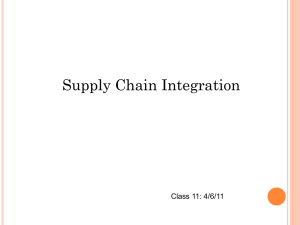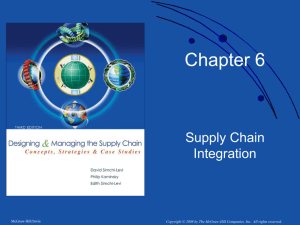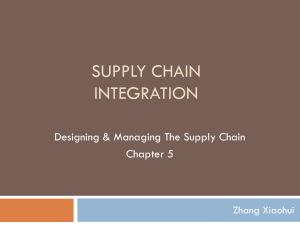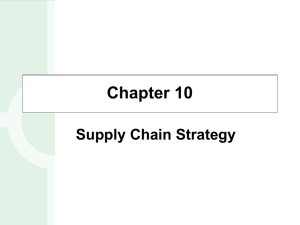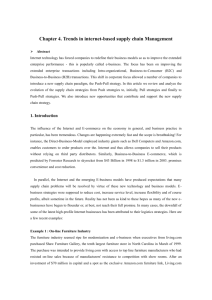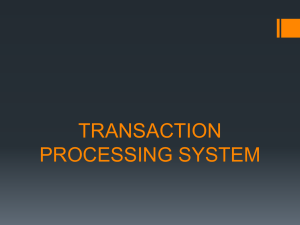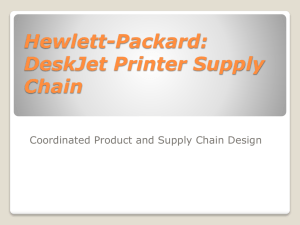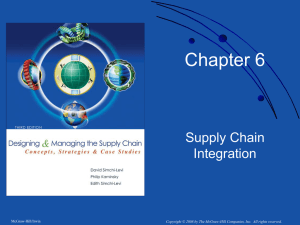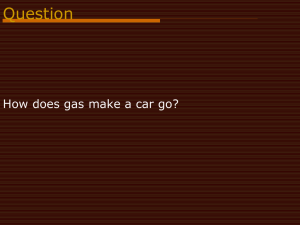Chapter 5 Supply Chain Integration
advertisement
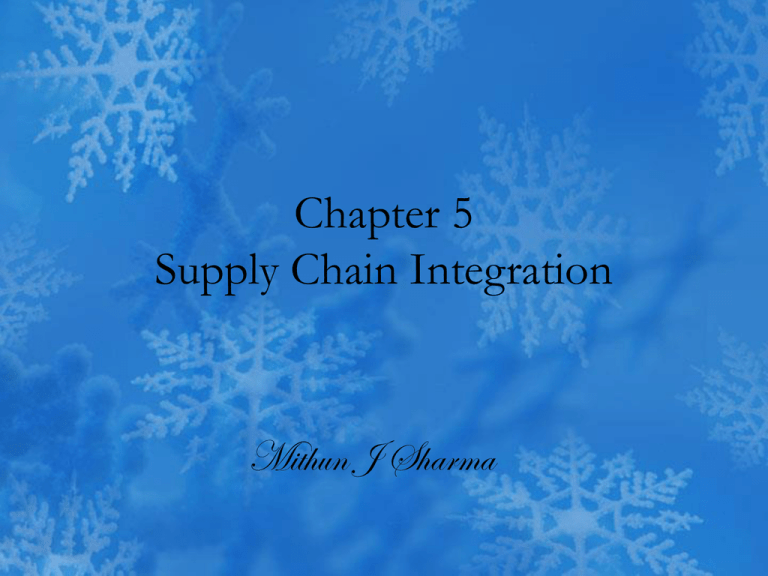
Chapter 5 Supply Chain Integration Mithun J Sharma Case Study Modern Book Distribution, Inc. • MBD had been one of the largest efficient book distributors in the country. • They use advanced forecasting technique to control inventory levels and technological advanced warehouses to control operating expenses. • Evolution of two new types of retailers in the industry: large superstores & online stores Case Study Modern Book Distribution, Inc. • Challenges from large superstores: • They demand new services from their distributors. • As the superstores consolidated they used this leverage to force distributors to accept minimal margins Case Study Modern Book Distribution, Inc. • Challenges from online book sellers • Previously, the online book sellers kept no inventory at hand and relayed them to MBD like distributors to deliver the books to the retailer. • Online book sellers later established their own DCs, due to magnification of their business, where they kept inventory and handled packaging & shipment of books directly to end users. Case Study Modern Book Distribution, Inc. • The changing business scenarios lead MBD to embark on a different strategic model and the list of queries popped by the manager are: • The impact of internet on business strategy used by the new categories of book sellers • The utilization of internet by MBD to better serve the customers • Whether or not to move to pull distribution strategy Contents • Push, Pull and Push-pull Base Supply Chain • Demand driven supply chain strategies • Impact of internet on supply chain integration • Effective distribution strategies Push –Based Supply Chain • Production & distribution decisions are based on long term forecasts • Push-based SC reacts slowly to the changing market demand • Variability in orders lead to bullwhip effect • In push-based SC there is increased transportation costs, high inventory levels, and/or high manufacturing costs due to emergency production change over. Pull-Based Supply Chain • Production and distribution are demand driven so that there is co-ordination with the customer demand • Pull-based supply chain leads to decrease in lead time, decrease in inventory in retailers, decrease in variability in system, decreased inventory at manufacture due to reduction in variability • Pull-based systems are often difficult to implement due to long lead times, difficult to take advantage of economies of scale in manufacturing & transportation Push-pull Supply Chain • Initial stages are push based and later stages are pull based PushPull boundary Push Strategy Pull Strategy Raw Materials End Customer Supply chain time line Matching Supply Chain Strategy Demand Uncertainty Pull Push H I Computer II Furniture IV Books & CDS III Grocery Economies of Scale L L H Pull Push Implementing push-pull strategy • Push strategy implemented – demand uncertainty small, so long term forecast • Pull strategy implemented – uncertainty high so based on realized demand • Push portion – service level low – focus on cost minimization • Pull portion – high service level – focus on flexibility and responsiveness Characteristics of the Push & Pull portions of Supply Chain Portion Push Pull Objective Minimize cost Maximize service level Low Complexity High Focus Responsiveness Lead time Resource allocation Long Processes SC planning Order fulfillment Short Demand-Driven Strategies • The two processes to integrate demand information into supply chain planning process: • Demand forecast: A process in which historical demand data are used to develop long-term estimates of expected demand • Demand shaping: A process in which the firm determines the impact of various marketing plans such as promotion, discounts, rebates etc. on demand forecast Demand-Driven Strategies • In either of the cases demand forecast is not accurate so an important output from both the processes is forecast error. • This information insight into likelihood that demand will be higher or lower than the forecast Demand-Driven Strategies • Approaches to decrease forecast error and increase forecast accuracy are: • Select push-pull boundary to aggregate demand across products, geography, and time • Use market analysis & demographic and economic trend • Incorporate collaborative planning and forecasting processes with customers to better understand the market demand,… Impact of the Internet on SC Strategies • E-business: is a collection of business models and processes motivated by Internet technology and focusing on improvement of extended enterprise performance • E-commerce: is the ability to perform major commerce transaction electronically. Impact of the Internet on SC Strategies • Grocery industry: low level of demand uncertainty for many products and high economies of scale in transportation cost – push strategy more appropriate • Book industry: Inventory at the warehouse is based on push strategy whereas demand is satisfied based on pull strategy • Retail industry: push strategy for high volume, fast moving products and push-pull strategy for low volume, slow moving products Impact on Transportation & Fulfillment Traditional fulfillment E-fulfillment SC strategy Push Push-pull Shipment Bulk Parcel Reverse logistics Small part of business Imp. & complex Delivery destination Small no. of stores Large no. of geographically dispersed customers Lead times Relatively long Relatively short Distribution Strategies Strategy Attribute Direct Shipment Cross-Docking Risk pooling Take advantage Transportation Cost Holding costs Allocation Inventory at warehouses Reduced Inbound cost No warehouse cost Reduced Inbound cost No holding costs Delayed Delayed Distribution Strategies • Transshipment: shipment of items between different facilities at the same level in the supply chain to meet some immediate need • Centralized Vs Decentralized Control: • Centralized control – leads to global optimization • Decentralized control – leads to local optimization Distribution Strategies • Central Vs Local facilities • Safety stock: Consolidating warehouses lowers safety stock • Overhead: Few large central warehouses overhead cost < many small warehouse cost • Economies of scale: can be realized on consolidation of manufacturing units • Lead time: reduced lead time directly proportional to closer market area location Distribution Strategies • Service: Centralized warehousing enables the utilization of risk pooling, which means that more orders can be met with lower total inventory level. • Transportation cost: Transportation costs are directly related to the number of warehouses. Inbound transportation cost increases whereas outbound cost decreases due to service facility location Conclusion • Internet has created the opportunity to revolutionize the supply chain strategies but at the same time the collapse of many internet companies implies the great challenges that ebusiness presents. The new push-pull strategy advocates holding inventory. There is a need to have an effective distribution strategy depending on the details of the context, as mentioned in the presentation such as cross docking, transshipment and so on.. Case study The Great Inventory Correction • The problem• Due to fall in demand the high tech companies were loaded with rapidly depreciating goods • They had to write-off huge unsalable inventory New Logic • Altra designs programmable logic devices (PLDs). • Altra’s outsourcing manufacturer is based in Taiwan. • Initially there was a push strategy i.e. the finished goods were stockpiled in Asian facilities in anticipation of customer demand • Also it build new products based on specs beyond what customer needed for prototyping • The benefit of this model was to provide cost advantage to customers by holding the inventory stock in the supply chain New Logic • Change in strategy: • Continue to produce stock but in die banks i.e. to keep inventory in flexible form • Implement “build-to-order” strategy • New order will be built on customer order Visible Improvements • The average cycle time for semi-conductors is 117 according to research (from fab to customer) • Plenty of time for demand to change direction • Altra collaborated with Nortel & Motorola on product development • Introduced software system (SCM i2 Tech.) which is linked to fabs, suppliers, and distributors Visible Improvements • Result: reduced cycle time from 10 to 1day and long term cycle time from 4 weeks to 1 week. • UMC’s customer can forecast collaboratively using UMC’s web portal such that it automatically finds the best slot for the customer order. Freak/Flop show • Even after using SCM software , it couldn’t prevent inventory glut. Growth changed from 40 % to negative 10% • Reasons: New technology creates constraints in supply. Ordering overly creates glut on the manufacturer’s side Check on Business History • Flextronics an EMS company had unusually high inventory glut but they had a good reason for that because they wanted to obtain better understanding of with customers of consumer demand. • The company wanted to create material hub but there was some disputes with the distributors who complained of surplus inventory. The case was opposite in the year 2000 when there was a shortage and the distributors made good margin. IBM – The Crystal Ball • IBM follows the pull strategy or just-in-time basis. Their suppliers have visibility of their inventory level • The pull strategies IBM applies in order to make it effective are: • Commonality across platforms & products • The number of suppliers kept small • Electronic purchase transaction to have faster collaboration with suppliers • Rationally exuberant sales force who knows their customers in and out, the main strategy for their forecast, meet frequently to discuss & anticipate demand Thank You
